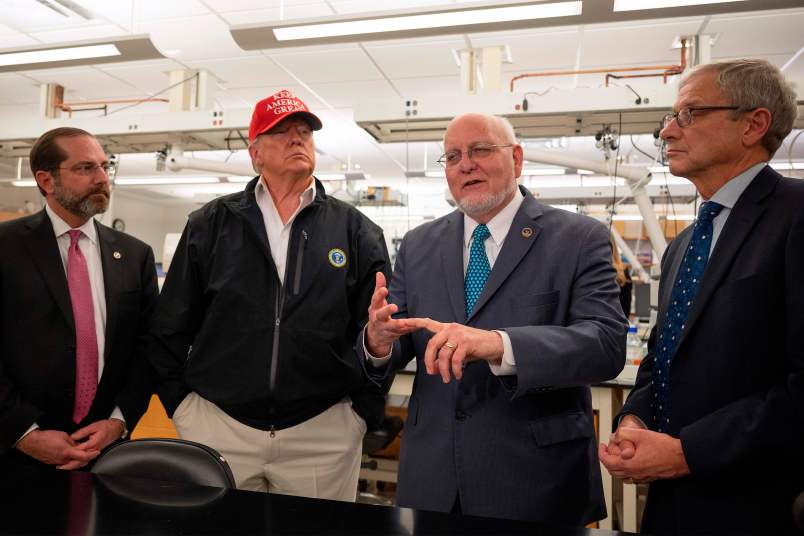The Trump administration on Wednesday played into suspicions that the timeline for a COVID-19 vaccine approval and release would be political, as it released detailed plans for the distribution of a COVID-19 vaccine across the country in the coming months.
Officials with Operation Warp Speed held a press call on Wednesday morning to herald the plans, but also made a few telling admissions on where and when the vaccine may be headed.
Paul Mango, a former health care consultant who now works as deputy chief of staff for policy at the Department of Health and Human Services, said that the Trump administration was targeting the final three months of 2020 for distributing the vaccine.
That timeline begins next month, as the Trump administration faces an effort to distribute vaccines whose efficacy and safety parameters remain unknown.
“The message we want you to leave with is that we are prepared for all of those uncertainties,” Mango said, adding that demand would first exceed supply in what he described as the “constrained phase of vaccine distribution.”
“Think about that as fourth quarter 2020,” Mango said. “As supply equals demand and exceeds demand into 2021, our distribution principles will change.”
President Trump himself said in comments later on Wednesday that the vaccine would come out in mid-October.
“We’re very close to that vaccine, as you know, I think closer than most people want to say, certainly closer than most people understand,” Trump said. “We think we can start sometime in October, so as soon as it’s announced, we’ll be able to start. That will be from mid-October on.”
#BREAKING: President Trump says vaccine could be out by mid-October: "We think we can start sometime in October." pic.twitter.com/9wEq9TjYFC
— The Hill (@thehill) September 16, 2020
Health care workers, essential workers and vulnerable populations would likely be first in line for a vaccine.
But no COVID-19 vaccine can be distributed without some form of approval from the Food and Drug Administration.
That will likely come in the form of an Emergency Use Authorization, a tool regulators have to issue early approvals for treatments that may be useful but which have not fully undergone testing for efficacy and safety.
In the case of the COVID-19 vaccines, three candidates are in mass phase III trials. The big questions around a COVID vaccine have boiled down to what level of evidence the FDA will require to issue an emergency approval, and whether the FDA will listen to the independent scientific boards that typically weigh in on vaccine approvals.
Meanwhile, President Trump has publicly pressured the FDA to approve a vaccine before the November election, with some senior Trump campaign officials reportedly describing an early approval as a “holy grail” for the President’s re-election.
The result has been unprecedented political pressure on the FDA to approve a vaccine along a political, and not medical, timetable.
The Operation Warp Speed call Wednesday morning reflected that thinking. One administration official admitted that the vaccine’s efficacy would not be known “until phase III trials are complete.”
Two of the trials have yet to complete enrollment, while one completed enrollment this morning. In the two vaccine candidates that are the furthest along, from Moderna and Pfizer, patients receive two shots, one month apart, lengthening the time it will take to determine whether they are safe and effective, or even how effective they may be.
But the timeframe offered in government documents further gives away that the Trump administration is planning for a late fall distribution.
An appendix to the CDC’s vaccine “playbook” lays out three potential vaccine distribution scenarios, with the proviso that the scenarios “are still considered hypothetical” and subject to FDA authorization.
The scenarios run through how much vaccine may be available this fall should the FDA issue an emergency authorization, saying that up to 3 million doses could be available by the end of October 2020 if both the Pfizer and Moderna candidates receive approval, and that the same two vaccines receiving approval could lead up to 30 million doses being available for distribution by late November.
The CDC is clear that these are planning documents, meant to reflect what would happen if FDA approval is given by late October. As it stands, the key scientific advisory panel that advises the FDA on whether to approve or reject vaccines — VRBPAC — has one meeting scheduled for late October, but it specified in the agenda that “no specific application will be discussed at this meeting.”
Overall, the notion of having a specific “deadline” to meet for a vaccine approval has been met with criticism from experts.
“We don’t want to race to a certain date, because we want that approval to be done thoroughly and correctly,” Claire Hannan, executive director of the association of immunization managers, told TPM earlier this month.
Or, as the President put it after this morning’s call:
Vaccines are moving along fast and safely!
— Donald J. Trump (@realDonaldTrump) September 16, 2020







I can’t distinguish the downplaying from the up-playing.
Well, you obviously don’t have herd mentality…
Not that it’s true or anything.
At this point, who do they think is going to take their vaccine? Not the practical science-believers, because they know the process is rushed and unsafe. And not the Trumpsters, because they don’t believe that COVID is real.
That’s because you’re trying to.